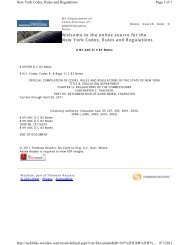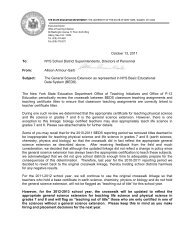ESL Learning Standards - Higher Ed - New York State Education ...
ESL Learning Standards - Higher Ed - New York State Education ...
ESL Learning Standards - Higher Ed - New York State Education ...
You also want an ePaper? Increase the reach of your titles
YUMPU automatically turns print PDFs into web optimized ePapers that Google loves.
Students learning English as a second language will use English to express their opinions and<br />
judgments on experiences, messages, ideas, information, and issues from a variety of perspectives.<br />
They will develop and use skills and strategies appropriate to their level of English proficiency to<br />
reflect on and analyze experiences, messages, ideas, information, and issues presented by others<br />
using a variety of established criteria.<br />
Performance Indicators: See page 20<br />
Advanced<br />
On the basis of their own interests, pairs of students find at<br />
least three advertisements for one product they use. The<br />
pair then uses class-developed assessment rubrics to analyze<br />
the advertisements, looking for sources of appeal, and<br />
fallacies or truth in marketing. They then create their own<br />
advertisement for the product on poster board. The class<br />
votes for and discusses the most appealing, truthful, and<br />
convincing advertisements.<br />
Performance indicators: 1, 2, 4, 5, 6, 7, 9<br />
English Proficiency Level<br />
Transitional<br />
Students brainstorm qualities that make commercial ads<br />
convincing. Class then views an infomercial. Working in<br />
small groups, students brainstorm the ways in which the<br />
infomercial did or did not succeed in convincing the audience<br />
to buy the product, and share their findings with the<br />
whole class. Students write an extended essay in which<br />
they analyze the infomercial’s marketing strategies with reference<br />
to its appeal, values, fallacies, and truthfulness.<br />
Small groups send recommendations for improvement of<br />
infomercial to producers.<br />
Performance indicators: 1, 2, 3, 4, 5, 6, 7, 8, 9, 10, 11, 12<br />
Students read two opposing editorials on a current social or<br />
political topic. Working in small groups, they research the<br />
issue in the library and/or on the Internet, and take notes.<br />
Each student independently writes a letter to the editor<br />
either agreeing or disagreeing with the editorials they read,<br />
using gathered information and data as support<br />
Performance indicators: 1, 2, 3, 4, 5, 6<br />
Students read a short story, memoir, or essay in which the<br />
writer is faced with a dilemma and resolves it. As a whole<br />
class, students brainstorm other ways in which the writer<br />
could have chosen to respond to the problem. Each student<br />
then writes a letter to the author, agreeing with the author’s<br />
decision or giving an alternative method of solving the<br />
problem.<br />
Performance indicators: 1, 2, 3, 6<br />
Students complete Intermediate task. They read a brief<br />
memoir, diary, or short story on an immigration experience.<br />
In pairs, they use a graphic organizer to compare and contrast<br />
the author’s experience of immigration with their own<br />
or a family member’s experience. Each student then writes<br />
a short essay based on the comparison, using examples<br />
and details from each. Essays are collected, peer edited,<br />
and compiled into a class book on immigration experiences.<br />
Performance indicators: 1, 3, 4, 6, 7, 9<br />
Students choose and research a social or political issue, and<br />
write a persuasive speech in which they present their own<br />
point of view on the subject. They deliver the speech to<br />
the class. Peers use a student-created rubric to evaluate the<br />
speeches, including such items as persuasiveness, truth,<br />
clarity, and effectiveness of the speaker.<br />
Performance indicators: 1, 2, 3, 4, 5, 6, 8<br />
Students read two differing reviews of a film viewed in<br />
class. Following these models, students in small groups<br />
write a review in which they provide a summary of the<br />
plot, information about the characters, and comments on<br />
the effectiveness of the acting, directing, and other features.<br />
They make their own recommendation about whether or<br />
not to see the film, and present their review to the class.<br />
One review is submitted to the school newspaper.<br />
Performance indicators: 1, 2, 3, 5, 6, 7, 8<br />
Students read an essay about one aspect of the impact of<br />
immigration in U.S. history (e.g., economic development,<br />
population growth in cities, changes in traditional cuisine,<br />
etc.). They take double-entry notes on the passage to discuss<br />
with the whole class. Later, working in pairs, students<br />
research relevant facts about the topic and prepare a brief<br />
that supports or rebuts the author’s perspective.<br />
Performance indicators: 1, 4, 6, 7, 9<br />
Continued on next page<br />
<strong>ESL</strong><br />
3<br />
Comm<br />
CLASSROOM<br />
TASKS<br />
Sample Classroom Tasks 97
















